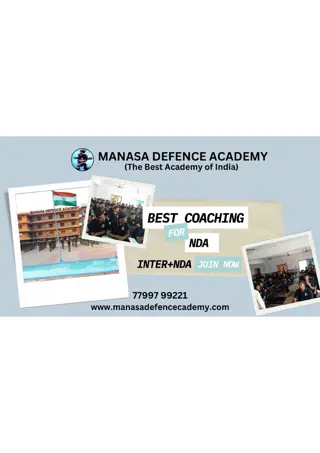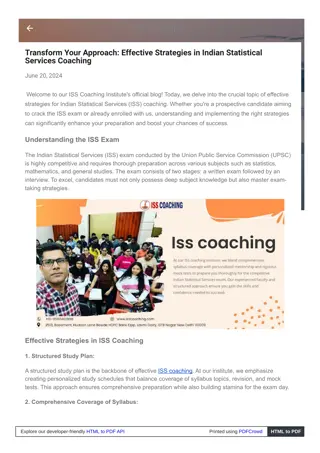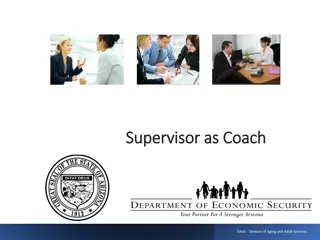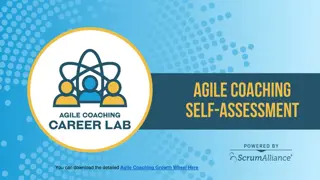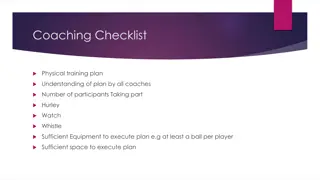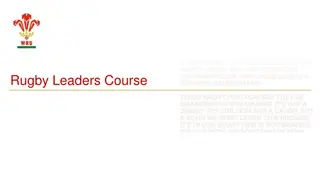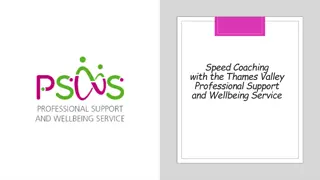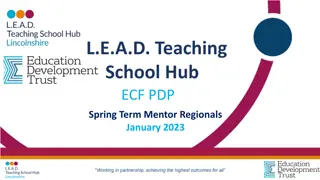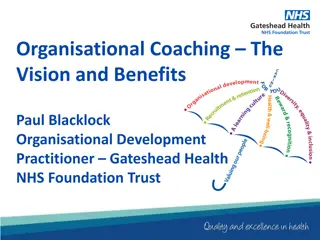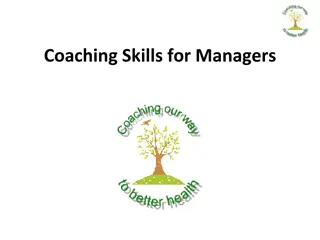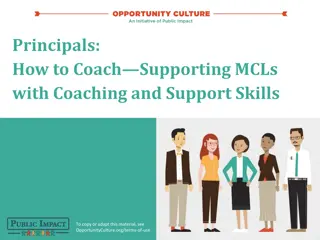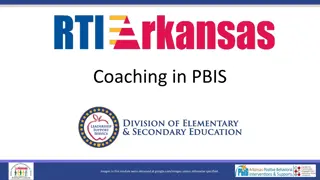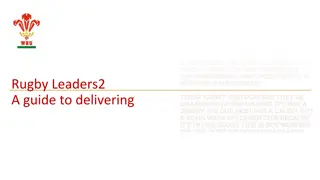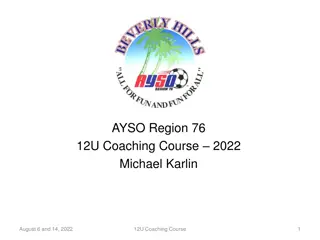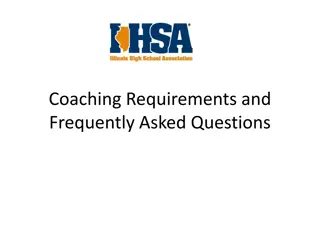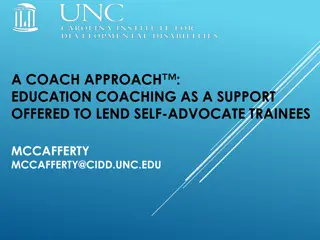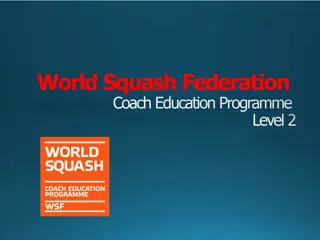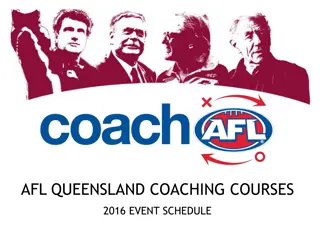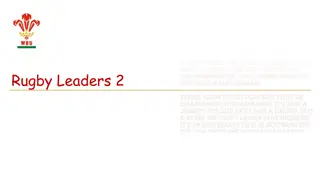Comprehensive Guide to Coaching in Multi-Classroom Leadership
Explore the key concepts of coaching in a multi-classroom leadership setting, covering topics such as defining coaching, components of a coaching cycle, tools for observations, leading coaching conversations, feedback vs. coaching, the coaching cycle process, formal vs. informal observations, and observation best practices. Gain insights into professional development and practices to help adult learners improve their skills and achieve their goals.
Download Presentation

Please find below an Image/Link to download the presentation.
The content on the website is provided AS IS for your information and personal use only. It may not be sold, licensed, or shared on other websites without obtaining consent from the author.If you encounter any issues during the download, it is possible that the publisher has removed the file from their server.
You are allowed to download the files provided on this website for personal or commercial use, subject to the condition that they are used lawfully. All files are the property of their respective owners.
The content on the website is provided AS IS for your information and personal use only. It may not be sold, licensed, or shared on other websites without obtaining consent from the author.
E N D
Presentation Transcript
Multi-Classroom Leadership Coaching Part 2: How to Coach To copy or adapt this material, see OpportunityCulture.org/terms-of-use 2019 |1
Do Now In your experience being coached or coaching others, how would you define coaching? Time for this activity: 2 minutes 2019 |2
Session Objectives Define coaching and discuss the components of a coaching cycle. Learn about tools used during informal observations and practice using tools. Learn about and practice using a protocol for leading coaching conversations. 2019 |3
What is Coaching? Coaching is professional development. Its purpose is to help an adult learner improve their practice. A coach is a facilitator of someone else s learning. - Elena Aguilar, author of The Art of Coaching 2019 |4
Feedback vs. Coaching What is the difference between feedback and coaching? What role can feedback play in coaching? Feedback Coaching Helps individuals be aware of strengths and areas of growth. Leads to acceptance that something needs to change. Helps individuals achieve the new goals that feedback helped them set. 2019 |5
The Coaching Cycle Build relationship, set vision, and norm on roles and expectations Observe teaching, looking for implementation of action steps Facilitate debrief conversation to deliver feedback and identify action step(s) Provide support, as needed (i.e. model lesson, co-teach, etc.) 2019 |6
Formal vs. Informal Observations Formal Observation High-stakes Evaluative Implications for contract renewal Summative Conducted by principal or AP Longer observation Informal MCL Observation Supportive Non-evaluative Timely, relevant Typically shorter observation 2019 |7
Observation Best Practices AFTER BEFORE DURING 1. Determine action step (if applicable) and note-taking tool to collect best data. 2019 |8
Generic, Quick Observation Tools See Handout T. Actions S. Actions 2019 |9
Strategy-Specific Observation Tools Verbal Flow Teacher Movement Teacher Questioning Overall Teaching Effectiveness 2019 |10
Before, During, & After an Observation AFTER BEFORE DURING 1. Determine action step (if applicable) and note-taking tool to collect best data. 1. Be on time 2. Focus on the pre- determined action step 3. Take evidence-based notes for specific feedback 2019 |11
Evidence-Based Notes Not Evidence-Based: Students are not engaged. Teacher s questions were not rigorous. Evidence-Based: 9:20 T: All eyes on me and a voice level 0. 11/26 students immediately follow direction. 9:22 15/26 students silent. Teacher is giving directions; no redirection or consequences given to remaining off- task students. 9:27 17/26 students silently following along in notes. 2019 |12
Before, During, & After an Observation AFTER BEFORE DURING 1. Determine action step (if applicable) and note-taking tool to collect best data. 1. Be on time 2. Focus on the pre- determined action step 3. Take evidence-based notes for specific feedback 4. Give in-the-moment feedback and support, as needed 5. Provide quick feedback on sticky note before you leave (optional) 2019 |13
Observation: Practice! 2019 |14
Before, During, & After an Observation AFTER BEFORE DURING 1. Determine action step (if applicable) and note-taking tool to collect best data. 1. Be on time 2. Focus on the pre- determined action step 3. Take evidence-based notes for specific feedback 4. Give in-the-moment feedback and support, as needed 5. Provide quick feedback on sticky note before you leave (optional) 1. Schedule debrief conversation 2. Review notes to determine strengths and areas of growth 3. Prep for debrief conversation 2019 |15
How to Coach: The Coaching Cycle Build relationship, set vision, and norm on roles and expectations Observe teaching, looking for implementation of action steps Facilitate debrief conversation to deliver feedback and identify action step(s) Provide support, as needed (i.e. model lesson, co-teach, etc.) 2019 |16
Six Steps for Effective Feedback A framework from Bambrick-Santoyo's book Leveraging Leadership. Bambrick-Santoyo, Paul (2012). Leverage Leadership: A Practical Guide to Building Exceptional Schools. San Francisco: Jossey-Bass. 2019 |17
Coaching Conversation Protocol See Handout Name it See it Action Step Praise Probe Plan Ahead Practice Follow-up Do it Bambrick-Santoyo, Paul (2012). Leverage Leadership: A Practical Guide to Building Exceptional Schools. San Francisco: Jossey-Bass. 2019 |18
Probing Questions Narrow the Focus Begin with the Purpose Focus on one aspect of the lesson. Prioritize the area where you will generate the action step. Avoid: How did your lesson go? Try: We ve been working on transitions. How do you think your students did with transitions today? Ask teachers to articulate the essential reason why they are focusing on a given strategy. Why do we use student prompting? What does it mean for students when they transition efficiently between activities? Why do we narrate the positive after giving directions? Bambrick-Santoyo, Paul (2012). Leverage Leadership: A Practical Guide to Building Exceptional Schools. San Francisco: Jossey-Bass. 2019 |19
Action Step Examples Reduce student talking when you re speaking. Don t talk over students. Stop and make eye contact with the student who is talking. Be careful about your pacing so you leave enough time for independent practice. Set a timer to go off with 20 minutes left in the lesson to remind you that you need to begin independent practice. Restate (or have students restate) expectations for entering the classroom, then have them re- enter to set the mood for learning and reinforce good behaviors. Keep students calm as they enter the classroom. Bambrick-Santoyo, Paul (2012). Leverage Leadership: A Practical Guide to Building Exceptional Schools. San Francisco: Jossey-Bass. 2019 |20
Criteria for Action Steps The probe that you ask your teacher should lead them to identify their own action step. Action steps should : Address a root cause affecting student learning Does the action step address a root cause or a symptom? Be highest leverage Will this help the teacher to develop most quickly and effectively? Be clear and measurable Can anyone understand the action? Can you easily measure if the teacher has made the change? Be bite-size If you can t make the change in a week, the action step isn t small enough. Bambrick-Santoyo, Paul (2012). Leverage Leadership: A Practical Guide to Building Exceptional Schools. San Francisco: Jossey-Bass. 2019 |21
Coaching Demonstration Bambrick-Santoyo, Paul (2012). Leverage Leadership: A Practical Guide to Building Exceptional Schools. San Francisco: Jossey-Bass. 2019 |22
Coaching Conversation Protocol Action Step Praise Probe Plan Ahead Practice Follow-up Bambrick-Santoyo, Paul (2012). Leverage Leadership: A Practical Guide to Building Exceptional Schools. San Francisco: Jossey-Bass. 2019 |23
Practice! See Handout Directions: Prep your coaching conversation using the blank template. Time for this activity: 10 minutes 2019 |24
Practice! Time Allotted Activity 6 minutes Role-play the coaching conversation. Partner 1 is MCL. Partner 2 is team teacher. 2 minutes Debrief the conversation: What was strong about your partner s facilitation of the coaching conversation? What improvement would you suggest? What are you taking away from this role play to implement in your own coaching practice? Switch roles 2019 |25
Debrief Role-Play What parts of the coaching conversation felt most natural? What was strong about your partner s facilitation of the coaching conversation? What parts were difficult? Which parts do you feel you need more practice? What outstanding questions do you have about facilitating coaching conversations? 2019 |26
Action Steps Write down and share a few next steps you commit to incorporating into your work based on your takeaways from this session. Next Steps People Timeline Notes 2019 |27
1 Sources Bambrick-Santoyo, P. (2012). Leverage leadership: A practical guide to building exceptional schools. San Francisco, CA : Jossey-Bass. Observing and Planning Effective Conferences with Beginning Teachers Characteristics of Useful Feedback How to Select the Right Classroom Observation Tool Coaching Protocol for Post-Observation Reflection Meeting Video Danielson Framework Implementation Forms Classroom Peer Observation 2019 |28
Coaching Conversation Protocol Action Step Praise Probe Plan Ahead Practice Follow-up Bambrick-Santoyo, Paul (2012). Leverage Leadership: A Practical Guide to Building Exceptional Schools. San Francisco: Jossey-Bass. 2019 |30
Practicing Teacher Actions 2019 |31
Follow Us! Keep up to date on Opportunity Culture with resources and research from Public Impact by following: @OppCulture @PublicImpact Facebook.com/OpportunityCulture Facebook.com/PublicImpact LinkedIn.com/company/public-impact---chapel-hill-nc Subscribe to the quarterly Opportunity Culture newsletters, with content by and for Opportunity Culture educators, and sign up to get Remind messages for them: Remind.com/join/ocnew OpportunityCulture.org/mailing-list/ 2019 |32



